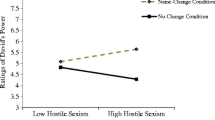Abstract
The relationships between relative and absolute contributions of resources and perceiving oneself as being powerful in the dating relationship were examined for 50 dating couples. Unlike past research examining resources as bases of power, a wide range of resources was examined—including more traditional “feminine” resources such as affection and companionship. Also unlike past studies, perceived contributions of resources, rather than the control of resources, were examined. How access to alternative relationships relates to power was also examined in this study. Contrary to research examining control of resources, it was found in this study that contributing more to the relationship tended to be negatively correlated with perceiving oneself as having power. Closer analysis revealed that this was particularly true for traditionally feminine resources. It was also found that the more men perceived themselves as having access to alternatives, the more powerful they perceived themselves. For women, on the other hand, an important basis of power appeared to be the control of the reciprocation of love in the relationship.
Similar content being viewed by others
References
Bernard, J. The future of marriage. New York: Bantam, 1972.
Blau, P. M. Exchange and power in social life. New York: Wiley, 1964.
Blood, R. O., & Wolfe, D. M. Husbands and wives. New York: Free Press, 1960.
Cook, K. S., & Emerson, R. M. Power, equity, commitment in exchange networks. American Sociological Review, 1978, 43, 721–739.
Coombs, R. H., & Kendell, W. F. Sex differences in dating aspirations and satisfaction with computer-selected partners. Journal of Marriage and the Family, 1966, 28, 62–66.
Dion, K. L., & Dion, K. K. Correlates of romantic love. Journal of Consulting and Clinical Psychology, 1973, 41, 51–56.
Dion, K. L., & Dion, K. K. Correlates and behavioral correlates of romantic love. In M. Cook & G. Wilson (Eds.), Love and attraction. London: Pergamon, 1979.
Emerson, R. Power-dependence relations. American Sociological Review, 1962, 27, 31–41.
Gillespie, D. L. Who has the power? The marital struggle. Journal of Marriage and the Family, 1971, 33, 445–458.
Hill, C. T., Rubin, Z., Peplau, L. A., & Willard, S. G. The volunteer couple: Sex roles, couple commitment, and participation in research on male-female relationships. Social Psychology Quarterly, 1979, 42, 415–420.
Hobart, C. W. The incidence of romanticism during courtship. Social Forces, 1958, 36, 362–367.
Kanin, E. J., Davidson, D.K.P., & Scheck, S. R. A research note on male-female differentials in the experiences of heterosexual love. The Journal of Sex Research, 1970, 6, 64–72.
Knox, D. H., & Sporakowski, M. J. Attitudes of college students toward love. Journal of Marriage and the Family, 1968, 30, 638–643.
McDonald, G. W. Family power: Reflection and direction. Pacific Sociological Review, 1977, 20, 607–621.
McDonald, G. W. Family power: The assessment of a decade of theory and research, 1970–1979. Journal of Marriage and the Family, 1980, 42, 841–854.
Michel, A. Comparative data concerning the interaction in French and American families. Journal of Marriage and the Family, 1967, 29, 337–344.
Michener, H. A., & Suchner, R. Tactical use of social power. In J. Tedeschi (Ed.), The Social influence processes (pp. 239–270). Chicago: Aldine, 1972.
Peplau, L. A. Power in dating relationships. In J. Freeman (Ed.), Women: A feminist perspective (2nd ed.) (pp. 106–121). Palo Alto: Mayfield, 1978.
Reik, T. A psychologist looks at love. New York: Farrar and Reinhart, 1944.
Reis, H. T., Wheeler, L., Spiegel, N., Kernis, M. H., Nezlek, J., & Perri, M. Physical attractiveness in social interaction: II. Why does appearance affect social experience? Journal of Personality and Social Psychology, 1982, 43, 979–996.
Rubin, Z., Peplau, L. A., & Hill, C. T. Loving and leaving: Sex differences in romantic attachments. Sex Roles, 1981, 7, 821–835.
Safilios-Rothschild, C. The study of family power structure: A review 1960–1969. Journal of Marriage and the Family, 1970, 32, 539–552.
Safilios-Rothschild, C. Love, sex, and sex roles. Englewood Cliffs, N.J.: Prentice-Hall, 1977.
Thibaut, J., & Kelley, H. H. The social psychology of groups. New York, Wiley, 1959.
Waller, W. The rating and dating complex. American Sociological Review, 1937, 2, 727–734.
Walster, E., Aronson, V., Abrahams, D., & Rottman, L. The importance of physical attractiveness in dating behavior. Journal of Personality and Social Psychology, 1966, 4, 508–516.
Author information
Authors and Affiliations
Additional information
I would like to give a special thanks to Elizabeth Thomson for her assistance throughout the writing of this manuscript. Gratitude also goes to Elaine Hatfield and John DeLamater for their advice at earlier stages of the research.
Rights and permissions
About this article
Cite this article
Sprecher, S. Sex differences in bases of power in dating relationships. Sex Roles 12, 449–462 (1985). https://doi.org/10.1007/BF00287608
Issue Date:
DOI: https://doi.org/10.1007/BF00287608




